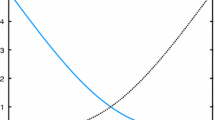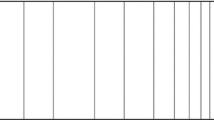The article describes a one-dimensional model of heat and moisture transfer in a building wall constructed from several layers of different porous materials. The model consists of a system of diffusion equations for heat, water vapor, and liquid water allowing for condensation of vapor and evaporation of water. An algorithm and a computer program are developed for numerical solution of the model equations by the finite-difference method. Two examples are given calculating the heat and moisture regime of constructions over a 50-year period with allowance for seasonal changes of temperature and air humidity.
Similar content being viewed by others
References
A. V. Lykov, Transfer Phenomena in Capillary-Porous Bodies [in Russian], Gostekhteoretizdat, Moscow (1954).
K. F. Fokin, Thermal Engineering of Building Walls [in Russian], Stroiizdat, Moscow (1973).
Handbook for Calculation of the Moisture Regime of Building Walls [in Russian], Stroiizdat, Moscow (1984).
Y. Ogniewicz and C. I. Tien, “Analysis of condensation in porous insulation,” Int. J. Heat Mass Transfer, 24, 421–429 (1981).
R. Kohonen, “Transient analysis of the thermal and moisture physical behaviours of building constructions,” Building and Environment, 19, 1–11 (1984).
H. M. Kiinzel and K. Kiessl, “Calculation of heat and moisture transfer in exposed building components,” Int. J. Heat Mass Transfer, 40, 159–617 (1997).
P. Haupl, J. Grunewald, H. Fechner, and H. Stopp, “Coupled heat air and moisture transfer in building structures,” lnt. J. Heat Mass Transfer, 40, 1633–1642 (1997).
N. Mendes, F. C. Winkelmann, R. Lamberts, and P. C. Philippi, “Moisture effects on conduction loads,” Energy and Buildings, 35, 631–644 (2003).
X. Fanga, A. K. Athienitis, and P. P. Fazio, “Methodologies for shortening test period of coupled heat-moisture transfer in building envelopes,” Applied Thermal Engineering, 29, 787–792 (2009).
M. Steeman, A. Janssens, H. J. Steeman, M. Van Belleghem, and M. De Paepe, “On coupling 1D non-isothermal heat and mass transfer in porous materials with a multizone building energy simulation model,” Building and Environment, 45, 865–877 (2010).
Author information
Authors and Affiliations
Corresponding author
Additional information
Translated from Prikladnaya Matematika i Informatika, No. 47, 2014, pp. 43–59.
Rights and permissions
About this article
Cite this article
Vasil’ev, G.P., Lichman, V.A., Peskov, N.V. et al. Numerical Modeling of Heat and Moisture Diffusion in Porous Materials. Comput Math Model 26, 501–513 (2015). https://doi.org/10.1007/s10598-015-9287-9
Published:
Issue Date:
DOI: https://doi.org/10.1007/s10598-015-9287-9




